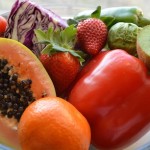
Iron-deficiency is something I see often as a student clinician at the Boucher Naturopathic Clinic in New Westminster, in both my pregnant and post-partum patients, and in women generally struggling with fatigue. Having your ferritin tested is easy and cheap (~$15 at our Naturopathic Clinic, free if your MD does the requisition). While MDs typically won’t flag a ferritin result unless it is under 15 ug/L (which is “diagnostic for iron deficiency”), Naturopathic Doctors are more likely to treat ferritin levels that are below 50 ug/L (which is indicative of “probable iron deficiency”). Take a look at any recent labs you’ve had done, you may find your ferritin levels are less than optimal! Here’s my top six tips to optimize your iron levels:
- Iron is an important mineral with numerous roles in the body, including oxygen delivery, energy production, metabolism and immune function.
- Low iron levels can lead to fatigue, decreased aerobic capacity, impaired mental concentration, mood disturbance, hair loss, menorrhagia, impaired immune function, restless legs, decreased thyroid function, intolerance to cold and pale conjunctivae.
- Iron levels are affected by three key factors:
- Intake – food or supplements
- How much you absorb –decreased by foods high in phytates (tea, coffee, wheat bran, soy), intake with other minerals, poor gut health (including h-pylori infections) and low stomach acid; absorption is increased by Vitamin C intake
- How much you lose – in menstrual periods, through breast milk, sweat and also in stools in some cases
- Recommended daily iron changes throughout your lifespan. RDA for children begins about 10 mg, rises to 15 mg for girls once menstruation begins, and increases to 18 mg in adult females. It increases to 27 mg in pregnancy, and decreases again after menopause to 8mg due to cessation of menstruation.
- Not all iron sources are created equal. The absorbability of “heme” iron (animal sources like meats and eggs) varies from 15-35%, whereas “non-heme” absorption (plant sources like beans and leafy green vegetables) varies from 2-20%.
- Top tips for maximizing your iron levels:
 Combine vegetarian iron sources with Vitamin-C. For example, have an orange or strawberries with your breakfast cereal, eat salsa with your bean burrito, or add red peppers to your lentil soup.
Combine vegetarian iron sources with Vitamin-C. For example, have an orange or strawberries with your breakfast cereal, eat salsa with your bean burrito, or add red peppers to your lentil soup.- Separate your iron-rich foods from your phytates (tea, coffee, soy and wheat bran) and your iron supplements from other minerals (including calcium, copper, zinc and manganese). This means avoiding multivitamins with multiple minerals, which compete for absorption.
- Seek an iron supplement with 25- 50 mg iron per capsule, at least 60mg of Vitamin C for absorption, as well as B-9 (folate) and B-12 to increase red blood cell health. Your Naturopathic Doctor can advise you which supplements are worth your money.
- Cook in a cast-iron skillet to increase the iron content in your foods.
- Avoid introducing cow’s milk to infants before the age of 6 months. This has been shown to contribute to iron-deficiency anemia in infants.
- Drink nutritive teas with iron-rich herbs like Red Raspberry (Rubus Idaeus), Dandelion (Taraxacum off), Nettles (Urtica Dioica) and Yellow Dock (Rumex crispus). Contact your Naturopathic Doctor to have a mineral-rich tea formulated for you.
- Choose iron-rich foods in each of your meals using the table below – they will add up quickly if you do so intentionally






